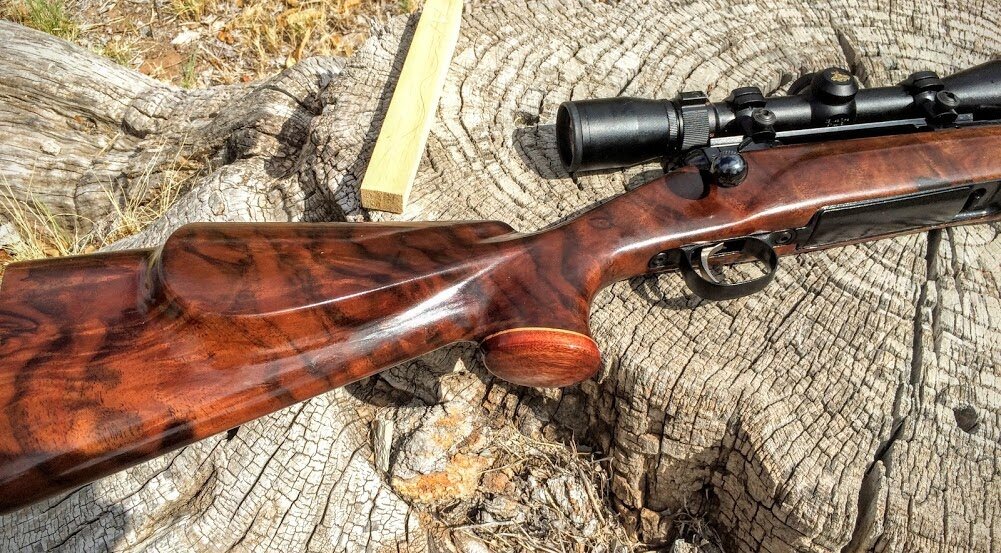How to Refinish a Rifle Stock With Tru-Oil
This is also a great process for guitars, so I’ve heard…
This is how my journey into woodworking started. I was 22-23, not a woodworker, but I wanted to fix up the Browning Citori Over and Under Shotgun my Grand-father bought me when I was 13. So I found a local gunsmith, went to his shop, and asked him to refinish the forearm to match the new stock. He told me, “No, do it yourself, it’s easy, let me show you.” And that was the start of my woodworking journey.
This is my rifle stock that I finish in my full video tutorial
If you’ve ever tried to have a gun stock refinished you’ve quickly discovered that most of the time you’re going to pay someone like me more than the gun is worth to have it done. We’re not trying to rip you off, finishing or refinishing a rifle stock is just time consuming, but other than that its pretty easy.
As long as you have a place to work on it. Spending a couple of hours every day for a week will get you as good of results as the best woodworkers, and gunsmiths. Birchwood-Casey Tru-Oil is an easy to use product that will give your gunstock a great looking finish.
This inexpensive kit will provide you will almost everything you need to finish your gunstock.
Click the Picture or this Link to Purchase (Affiliate Link)
There are only three steps to a great finish on a gun stock.
Remove the old finish
Sand it smooth
Apply the new finish
I’ve now disclosed all of the trade secrets…
Back to Grandpa’s Shotgun…
In my teens, I was hugely into competition shooting sports, specifically sporting clays. I was pretty good. My three-man team placed 2nd and 3rd overall in the Texas State 4H State Meet for a few years in a row.
My journey started when I was in 7th grade. When I started I used a few shotguns that my dad and grandpa had. Once I fell in love with the sport, my Papa (what I called him) decided I needed a proper shotgun for the sport. This was, in his mind, a high quality Browning Citori over and under.
There was just one issue… I was short and the stock was too long for me.
The solution…. We. Cut. The. Stock.
I then grew about a foot the next year… sigh
We added spacers then an adjustable length recoil pad, but the gun never looked the same. Those beautiful clean lines on high-gloss walnut were gone.
Fast-forward to my first wedding anniversary…
My wife found and bought a nice replacement stock for my shotgun. The issue was, the only one we could find, had a factory oil finish and mine had a factory high gloss finish. I figured I could get that fixed. The new, highly figured stock then sat in a box for a few more years.
When Papa died I finally took action
My Papa died from Alzheimers (If you have a loved one suffering from this horrible disease you have my sympathy, it is a terrible way to lose a loved one). His death is what drove me to action.
I found a local gunsmith and he promptly told me to refinish the stock myself… “Wait! What?! I’m not a woodworker!”
Step 1: Remove the Old Finish
He took a knife to my gun stock!
Isn’t this hideous? This is all the factory varnish scraped off with my pocket knife. Hold the sharp knife 90-degrees to the surface and scrape. It’s oddly satisfying.
I stood there in frozen horror as this gunsmith took out his pocket knife and proceeded to scrape a big hunk of finish off my stock.
“So you’ll do this until you get down to bare wood then you’ll sand it smooth.”
“Get some wood-striper and an old tooth brush for the checkering that way you don’t mess it up.”
Tools You’ll Need for Striping Your Stock
A sharp blade or scraper - This is the fasted way to remove the bulk of your finish. A Pocket Knife is fine or you can use a card-scraper
Sand-Paper in 80, 120, 180, 220, 320 grits - I don’t recommend power sanding, Hand-sanding with a sanding block is probably best. Tape off the checkering so you don’t risk damaging it. Here’s a good sandpaper pack
Chemical Striper - Chemical Strippers should always be your last resort. I hate using them and the more I learn about harsh chemicals the less I want to use them. But at times the it is best tool for the job. Put it into the checkering, let it sit and use a nylon bristle brush to remove the finish. It may take a while. Follow the instructions on the product you use.
This process will take time. Go slow and don’t rush it. You can use mineral spirits or water to “wet” the surface which will help you find missed spots of old finish.
Step 2: Sand, Sand, Sand
You got the old finish off, now you gotta get it smooth.
Here is the rifle stock for my Savage 30-06 sanded up to 220grit.
Always hand-sand with the grain if possible. Use sanding blocks to keep the profiles and lines sharp.
A sanding block doesn’t need to be fancy. It can be a dowel, a block of scrap wood, and yes your hand is sometimes the right tool for the job.
You’ll need to work through each grit of sand-paper until you hit 220 grit.
Full Video Guide
I’d do some things a little differently now but this will give you a good step-by-step guide for finishing a gunstock, guitar, or another small woodworking project.
Step 3 - Apply Tru-Oil
This is where things can get made complicated but don’t need to be. In my video I made it a little over-complicated. I think you get the same results by applying a coat, letting it dry, lightly wet sand, and repeat two more times.
This impromptu stand did a good job of holding the stock in place for me.
Three coats is all you really need. If you have a question leave a comment below and I’ll be sure to answer.
Finished Gun Stocks
(Some of these pictures are really old so I apologize for the poor quality)
My Browning Citori
This Beretta Stock is the one with all the finish scraped off in the earlier photo.
My Savage 30-06 Rifle Stock from the video. This is a gorgeous stock.
How you can support the Recreational Woodworker
Use our Affiliate Links to buy your supplies. (You can buy anything from the site and I still earn a small commission
Subscribe to my Youtube Channel








